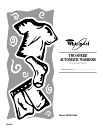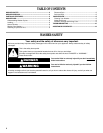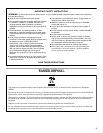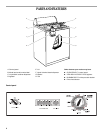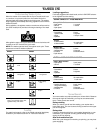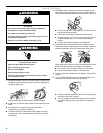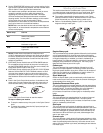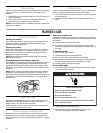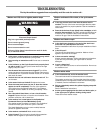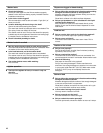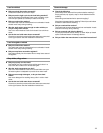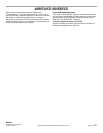
7
6. Set the TEMPERATURE selector to the correct setting for the
type of fabric and soils being washed. Use the warmest water
safe for fabric. Follow garment label instructions.
Your washer uses automatic temperature control (on some
models) to maintain a uniform water temperature by
regulating the incoming hot and cold water. This helps
eliminate undissolved detergent and ensures consistent
cleaning results. The Hot and Warm settings on this washer
will be cooler than you are accustomed to. Wash
temperatures in this washer are lower than the temperatures
you may be used to in conventional washers.
NOTE: Make sure that both the hot and cold water taps are
fully turned on, or the automatic temperature control feature
will not work properly.
NOTE: In wash water temperatures colder than 60ºF
(15.6ºC), detergents do not dissolve well. Soils can be difficult
to remove. Some fabrics can retain wear wrinkles and have
increased pilling (the formation of small lint-like balls on the
surface of garments).
7. (OPTIONAL) Some models have an EXTRA RINSE selector.
For an additional rinse and spin at the end of a wash cycle,
set the EXTRA RINSE selector to ON. On some models, the
Extra Rinse feature is part of the cycle.
8. (OPTIONAL) Some models have an END OF CYCLE SIGNAL
selector. Set the END OF CYCLE SIGNAL selector to ON if
you want your washer to alert you when the wash cycle is
complete. The signal is helpful when you are washing items
that should be removed from the washer as soon as the cycle
ends.
9. Push in the Cycle Control knob and turn it clockwise to the
wash cycle you want. Reduce the wash time when using a
small load size setting. See “Selecting a Cycle and Time.”
Pull out the Cycle Control knob to start the washer.
To stop or restart your washer
■ To stop the washer at any time, push in the Cycle Control
knob.
■ To restart the washer, close the lid (if open) and pull out
the Cycle Control knob.
Selecting a Cycle and Time
This section describes the available wash cycles and will help
you make the best cycle selections for your wash loads. Each
cycle is designed for different types of fabric and soil levels.
■ The washer pauses briefly throughout each cycle. These
pauses are normal. Refer to “Normal Sounds” to learn more
about the sounds you may hear during a wash cycle.
■ Refer to “Understanding Washer Cycles” to learn what
happens during a wash cycle.
Regular/Heavy cycle
This cycle features high-speed agitation followed by brief periods
of low-speed agitation for cleaning sturdy fabrics and heavily
soiled loads that need maximum soil removal. Select Super Wash
or Regular depending on whether your load is moderately or
heavily soiled. For improved cleaning, use twice the amount of
detergent recommended for a wash cycle. The Heavy cycle
features Extra Rinse as part of the cycle.
Cotton cycle
This cycle features high-speed agitation followed by a brief
period of low-speed agitation for cleaning cottons and linens.
High spin speeds shorten drying time. Select 9 to 18 minutes of
wash time for loads that are moderately or heavily soiled. For
lightly soiled loads, use the shortest time setting.
Super Wash cycle
Select the Super Wash cycle to wash heavily soiled loads that
need maximum soil removal. Use twice the amount of detergent
recommended for a wash cycle.
Synthetics/Permanent Press cycle
This cycle starts with high-speed agitation and then steps down
to low-speed agitation for cleaning permanent press blends and
synthetic fabrics. To minimize wrinkling, this cycle features a
cool-down rinse and a low-speed final spin. Select up
to 9 minutes of wash time to clean lightly to moderately soiled
loads.
Delicates cycle
This cycle features low-speed agitation for gentle soil removal
from delicate items and washable knits. Low spin speeds
minimize wrinkling. Select up to 6 minutes of wash time to clean
lightly to moderately soiled loads.
Soak cycle
This cycle features brief periods of agitation and soak time to
remove heavy soils and stains that need pretreatment. Use warm
water when soaking laundry. Hot water can set stains. Use the
amount of detergent or presoak additive recommended by the
manufacturer. When the Soak cycle ends, add detergent and
start a new wash cycle.
Prewash cycle
This cycle features a brief period of high-speed agitation to help
remove heavy soils and stains that need pretreatment. Use warm
water for prewashing stained laundry. Hot water can set some
stains. After the Prewash cycle ends, add detergent and select a
new wash cycle.
Water Temp Use For
Hot Whites and pastels
Heavy soils
Warm Bright colors
Moderate to light soils
Cold Colors that bleed or fade
Light soils



